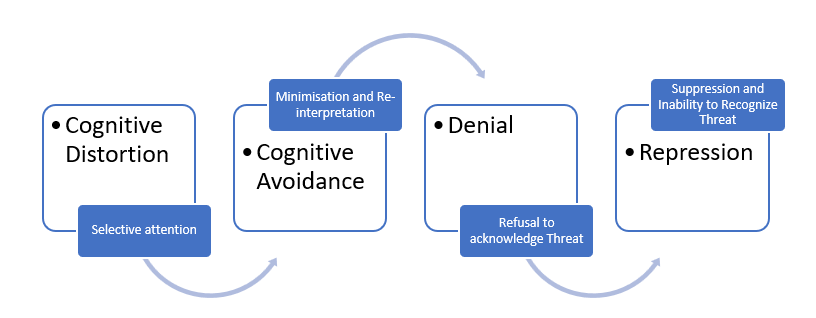Introduction
Perceptual defence is a crucial concept in psychology that explores how individuals manage and process information perceived as threatening or anxiety-inducing. This phenomenon is integral to understanding the cognitive and emotional mechanisms that help individuals cope with potentially distressing stimuli.
Perceptual defence involves a variety of cognitive processes designed to shield individuals from information that might provoke emotional discomfort or psychological harm. By examining how perceptual defence operates, psychologists gain valuable insights into the ways the mind protects itself from overwhelming or harmful information.
This exploration into perceptual defence involves several key aspects. The theoretical foundations provide the basis for understanding why perceptual defence occurs and what cognitive mechanisms are involved. These foundations are supported by empirical research that demonstrates how perceptual defence manifests in different contexts and populations. Additionally, the practical applications of perceptual defence in psychological practice reveal how this concept can be used to address various mental health issues. Finally, the broader implications of perceptual defence extend to a deeper understanding of human cognition and emotion, shedding light on how individuals navigate complex and often challenging emotional landscapes.
Theoretical Foundations of Perceptual Defence

Theoretical Concepts in Perceptual Defence
Perceptual defence is deeply embedded in the field of perceptual psychology, which studies how sensory information is processed and interpreted by the brain. The core idea of perceptual defence is that individuals can become less sensitive to or completely blind to stimuli that are perceived as threatening or anxiety-inducing. This concept is closely related to theories of cognitive distortion and avoidance, which suggest that the mind employs various strategies to filter out or reinterpret information to avoid emotional distress.
- Cognitive Distortion: Cognitive distortion refers to the ways in which individuals perceive and interpret information in a manner that is skewed by their emotional state or cognitive biases. Perceptual defence can manifest as cognitive distortion when individuals misinterpret or downplay threatening stimuli to make them less alarming. This process helps individuals maintain psychological stability and avoid confrontation with distressing information.
- Avoidance Mechanisms: Avoidance mechanisms are cognitive strategies used to evade or ignore information that causes discomfort or anxiety. In the context of perceptual defence, avoidance can involve actively ignoring or overlooking threatening stimuli, thereby preventing them from entering conscious awareness. This can be a useful strategy in situations where confronting the information might lead to significant emotional distress.
- Psychological Shielding: The concept of psychological shielding involves the mind’s ability to create a buffer against distressing stimuli. This shielding can occur through various cognitive processes, such as denial or repression, where threatening information is either outright denied or pushed out of conscious awareness. Psychological shielding serves as a defense mechanism that helps individuals manage their emotional responses and maintain psychological equilibrium.
Mechanisms of Perceptual Defence
Perceptual defence is a multifaceted phenomenon that involves a complex interplay of cognitive and emotional processes. The mechanisms behind perceptual defence are designed to protect individuals from the emotional impact of threatening or anxiety-inducing stimuli. These mechanisms include cognitive avoidance, selective attention, cognitive distortion, denial, and repression. Each of these mechanisms plays a role in how individuals manage and cope with distressing information.
- Cognitive Avoidance– It is a primary mechanism in perceptual defence. It involves the use of various strategies to ignore or distort threatening information. By engaging in cognitive avoidance, individuals effectively shield themselves from experiencing the full impact of distressing stimuli. This can manifest in several ways-
- Selective Attention– It is a cognitive process where individuals focus their attention on certain aspects of their environment while ignoring others. In the context of perceptual defence, selective attention involves concentrating on neutral or positive information while disregarding or avoiding threatening stimuli. For example, a person who is anxious about a potential job loss may focus on positive aspects of their current employment or other enjoyable activities, thereby reducing their exposure to distressing thoughts about job insecurity. This focus on less alarming information helps prevent the individual from becoming overwhelmed by distressing inputs.
- Cognitive Distortion- Refers to the alteration or reinterpretation of threatening stimuli to make them less alarming or distressing. This mechanism allows individuals to manage their emotional responses by modifying how they perceive and interpret potentially threatening information. Cognitive distortion can occur in several ways-
- Minimization– An individual might downplay the significance of a threatening message or situation. For example, if someone receives critical feedback at work, they might convince themselves that the feedback is not important or that it is a rare occurrence. This minimization helps reduce anxiety by making the threatening information seem less significant.
- Reinterpretation- Reinterpretation involves changing the way one understands a threatening stimulus to reduce its emotional impact. For example, if an individual interprets a negative comment from a friend as a reflection of the friend’s own insecurities rather than a personal attack, the emotional impact of the comment is lessened. By altering the interpretation of the stimulus, individuals can manage their emotional responses more effectively.
- Denial– It is a defence mechanism where individuals refuse to acknowledge the existence or significance of threatening stimuli. Denial serves as a psychological shield by preventing individuals from confronting information that could lead to emotional discomfort. This mechanism can manifest in various ways-
- Refusal to Acknowledge Threats– An individual might deny the reality of a threatening situation, such as an impending health issue. For example, someone who receives a serious medical diagnosis might refuse to accept the diagnosis or ignore medical advice, thereby avoiding the emotional distress associated with the diagnosis. Denial helps individuals maintain a sense of normalcy and avoid the anxiety that comes with acknowledging distressing information.
- Repression – It involves pushing distressing information out of conscious awareness, effectively keeping it from entering the individual’s conscious mind. This mechanism allows individuals to avoid dealing with distressing information directly. Repression can manifest in the following ways-
- Suppression of Memories– Repression often involves the suppression of unpleasant memories or experiences. For example, a person who has experienced a traumatic event might have difficulty recalling specific details of the event. By keeping these memories out of conscious awareness, individuals avoid the emotional pain associated with them. Repression allows individuals to function in daily life without being constantly overwhelmed by distressing thoughts.
- Inability to Recognize Threats– In some cases, individuals might be unaware of the extent to which they are affected by threatening stimuli. For instance, a person might not recognize that their anxiety is linked to unresolved issues from their past. Repression allows individuals to function without being constantly aware of the emotional impact of distressing information.

Perceptual Defence
Interaction of Mechanisms of Perceptual Defence
The mechanisms of perceptual defence often interact with one another, creating a complex network of cognitive and emotional processes designed to manage distressing stimuli. For example, cognitive avoidance strategies such as selective attention and cognitive distortion may work together to minimize the impact of threatening information. An individual might use selective attention to focus on positive aspects of their life while simultaneously engaging in cognitive distortion to reinterpret threatening information in a less alarming way. Similarly, denial and repression can operate in tandem to keep distressing information from conscious awareness, further protecting the individual from emotional discomfort.
Understanding these mechanisms provides valuable insights into how individuals cope with and manage distressing information. By recognizing the ways in which perceptual defence operates, psychologists can develop more effective therapeutic interventions and support strategies to help individuals navigate their emotional experiences. The mechanisms of perceptual defence are essential for maintaining psychological stability and managing emotional responses in the face of potentially overwhelming stimuli.
Historical Context and Early Research
The concept of perceptual defence has been studied extensively since the mid-20th century. Early research by Hans Eysenck (1967) played a crucial role in establishing the foundation for this concept. Eysenck’s studies investigated how anxiety levels influence the ability to detect and process threatening information. His research demonstrated that individuals with higher levels of anxiety were less likely to detect threatening words, suggesting that perceptual defence functions as a protective mechanism against emotional distress.
Eysenck’s work was further supported by research from Neisser and Becklen (1975) on selective attention. Their study showed how individuals might ignore or fail to notice distracting or distressing information in their environment. This research provided empirical evidence for the notion that perceptual defence involves selective processing of stimuli based on their emotional significance.
Bruner & Postman (1947) Experiment on Perceptual Defence
The Bruner and Postman (1947) experiment is a seminal study in psychology that explored the concept of perceptual defence. This experiment investigated how individuals perceive and interpret stimuli that conflict with their expectations or existing knowledge. The study is often cited for its insights into cognitive biases and the role of expectancy in perception.
Objective
The primary objective of Bruner and Postman’s experiment was to examine how expectations influence perceptual processes. Specifically, they wanted to understand how individuals perceive stimuli that are inconsistent with their expectations and whether such stimuli are subject to perceptual distortion or defence mechanisms.
Methodology
- Participants- The study involved undergraduate students as participants. They were divided into two main groups: those who were informed about the nature of the stimuli beforehand and those who were not.
- Stimuli- The stimuli used in the experiment were playing cards. The researchers employed cards with standard suits and numbers but manipulated the cards to include incongruent or unexpected features. For example, some cards had bizarre or inconsistent combinations, such as a red suit card with a black suit symbol or cards with ambiguous or confusing features.
- Procedure-
- Control Group- The control group was shown normal playing cards without any manipulations. They were asked to describe the cards and report their features.
- Experimental Group- The experimental group was shown the manipulated cards. Participants were not informed that the cards contained distortions. They were instructed to describe the cards and report what they saw.
- Measurement- The researchers measured two main variables:
- Accuracy of Perception- Whether participants accurately identified the manipulated features of the cards.
- Reaction Time- The time taken by participants to describe and identify the features of the cards.
Findings
- Perceptual Distortion- The results revealed that participants in the experimental group often experienced perceptual distortion. When presented with cards that had incongruent features, many participants reported seeing features that were not actually present on the cards. For example, a card with a red suit symbol might be perceived as having a black suit symbol. This suggests that individuals’ expectations significantly influenced their perceptual experience.
- Reaction Time- The reaction times of participants in the experimental group were longer compared to those in the control group. This delay in processing was attributed to the participants’ efforts to reconcile the unexpected features of the cards with their existing knowledge. The time taken to identify and describe the manipulated cards was greater because participants were trying to make sense of the incongruent stimuli.
- Expectancy Effects- The study demonstrated that participants’ expectations and preconceptions played a crucial role in shaping their perception. When confronted with stimuli that conflicted with their expectations, individuals experienced difficulties in accurately perceiving and reporting the features of the stimuli. This finding highlighted the concept of perceptual defence, where individuals’ cognitive biases and expectations distort their perception of ambiguous or threatening information.

Results of the Experiment
Implications
- Perceptual Defence- The Bruner and Postman experiment provided empirical evidence for the concept of perceptual defence. It illustrated how individuals might distort or ignore stimuli that are inconsistent with their expectations or beliefs. This research contributed to a broader understanding of how cognitive biases and emotional states influence perception.
- Cognitive Biases- The study highlighted the role of cognitive biases in shaping perceptual processes. It demonstrated that individuals’ expectations can lead to perceptual distortions, reinforcing the idea that perception is not always a direct reflection of external reality but is influenced by cognitive and emotional factors.
Applications of the Research
The findings from Bruner and Postman’s experiment have implications for various fields, including psychology, education, and clinical practice. Understanding perceptual defence can help in designing interventions and educational materials that take into account individuals’ cognitive biases and expectations. It also has applications in areas such as eyewitness testimony, where perceptual distortions can impact the accuracy of memory recall.
The Bruner and Postman (1947) experiment is a landmark study in psychology that explored the impact of expectations on perception. By using manipulated playing cards and examining participants’ responses, the study provided valuable insights into perceptual defence and cognitive biases. The findings underscored the influence of pre-existing knowledge and expectations on how individuals perceive and interpret stimuli, contributing to a deeper understanding of the complexities of perceptual processes.
Contemporary Research and Developments
In recent years, research on perceptual defence has expanded to include various cognitive and emotional processes. Studies have explored how perceptual defence operates across different contexts and populations. For example:
- Clinical Populations- Research has investigated perceptual defence in clinical populations, such as individuals with anxiety disorders, post-traumatic stress disorder (PTSD), and depression. These studies have shown that individuals with these conditions often exhibit heightened perceptual defence mechanisms, leading to difficulties in processing and coping with distressing stimuli (Barlow, 2002).
- Neuroscientific Approaches- Advances in neuroscience have allowed researchers to examine the neural mechanisms underlying perceptual defence. Functional magnetic resonance imaging (fMRI) studies have identified brain regions involved in processing threatening stimuli and revealed how these regions are modulated by cognitive defence mechanisms (Hariri et al., 2002).
- Developmental Research- Research has also explored how perceptual defence develops across the lifespan. Studies have shown that children and adolescents may exhibit different patterns of perceptual defence compared to adults, highlighting the role of cognitive development in shaping defensive processes (Cohen et al., 2004).

Application of Perceptual Defence
Practical Applications
Understanding perceptual defence has significant implications for psychological practice, particularly in therapeutic settings. Some practical applications include-
- Therapeutic Interventions- Therapists can use knowledge of perceptual defence to help clients become more aware of their defensive mechanisms. Techniques such as cognitive-behavioral therapy (CBT) can assist clients in identifying and challenging cognitive distortions and avoidance strategies. By addressing these mechanisms, therapists can help clients develop healthier ways to process and cope with distressing information (Beck et al., 1979).
- Trauma-Informed Care- In the context of trauma-informed care, understanding perceptual defence is crucial for providing effective support to individuals who have experienced trauma. Therapists can work with clients to gradually confront and process traumatic memories in a safe and supportive environment, helping them to reduce the impact of perceptual defence on their emotional well-being (van der Kolk, 2014).
- Education and Training- Educators and mental health professionals can benefit from training on perceptual defence to better understand how it affects individuals’ responses to distressing information. This knowledge can inform the development of interventions and support strategies tailored to the needs of different populations (Perry, 2006).
Implications for Psychological Theory
Perceptual defence has important implications for psychological theory and research. It challenges traditional models of perception and cognition by highlighting the role of emotional factors in shaping perceptual processes. This perspective underscores the need for a more integrated approach that considers both cognitive and emotional factors in understanding how individuals process and respond to stimuli.
Conclusion
Perceptual defence is a complex and multifaceted phenomenon that plays a crucial role in how individuals manage and process threatening information. Through mechanisms such as selective attention, cognitive distortion, denial, and repression, perceptual defence serves as a protective mechanism against emotional distress. Research on perceptual defence has evolved over the years, providing valuable insights into its underlying processes and implications for psychological practice.
By understanding perceptual defence, mental health professionals can develop more effective interventions and support strategies for individuals dealing with anxiety, trauma, and other emotional challenges. The continued exploration of perceptual defence in research and practice will enhance our understanding of how individuals navigate and cope with distressing stimuli, ultimately contributing to the advancement of psychological theory and practice.
References
Barlow, D. H. (2002). Anxiety and Its Disorders: The Nature and Treatment of Anxiety and Panic. Guilford Press.
Beck, A. T., Rush, A. J., Shaw, B. F., & Emery, G. (1979). Cognitive Therapy of Depression. Guilford Press.
Bruner, J. S., & Postman, L. (1947). Perception of incongruity: A paradigm. Journal of Abnormal and Social Psychology, 42(2), 159-170.
Cohen, A. J., Glick, R. M., & Covington, J. A. (2004). Developmental Changes in Perceptual Defence. Developmental Psychology, 40(1), 105-115.
Eysenck, H. J. (1967). The Biological Basis of Personality. Charles Scribner’s Sons.
Hariri, A. R., Tessitore, A., Mattay, V. S., & Weinberger, D. R. (2002). The Amygdala and the Emotional Response to Threats. NeuroImage, 17(1), 163-169.
Lazarus, R. S., & Folkman, S. (1984). Stress, Appraisal, and Coping. Springer Publishing Company.
Neisser, U., & Becklen, R. (1975). Selective Attention and Perception. Psychological Review, 82(6), 1040-1055.
Perry, B. D. (2006). Applying Principles of Neurodevelopment to Clinical Work with Traumatized Children. In C. A. Courtois & J. D. Ford (Eds.), *Treating Complex Traumatic Stress Disorders: An Evidence-Based Guide*. Guilford Press.
van der Kolk, B. A. (2014). The Body Keeps the Score: Brain, Mind, and Body in the Healing of Trauma. Viking.
Subscribe to Careershodh
Get the latest updates and insights.
Join 17,298 other subscribers!
Niwlikar, B. A. (2024, September 27). Perceptual Defence- Explore this Wonderful Concept with 1 Classical Experiment. Careershodh. https://www.careershodh.com/perceptual-defence/
